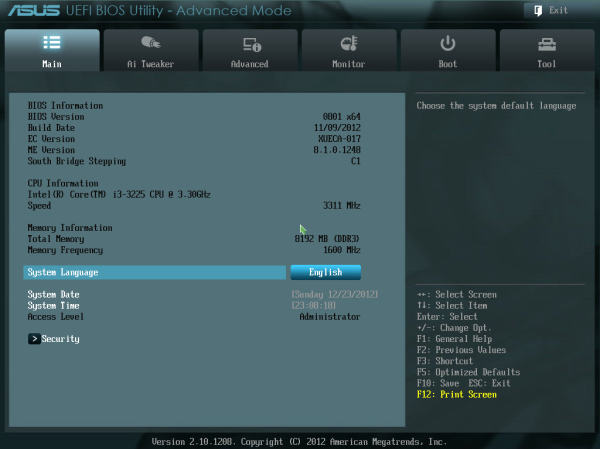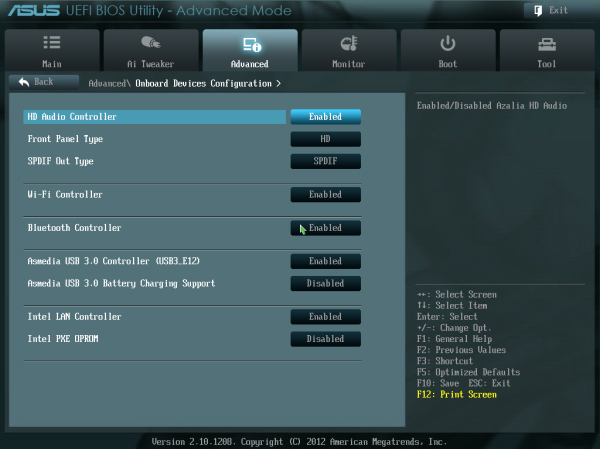Z77 mITX Round-Up: Five of the Best – MSI, Zotac, ASRock, EVGA and ASUS
by Ian Cutress on December 31, 2012 7:00 AM EST- Posted in
- Motherboards
- MSI
- ASRock
- EVGA
- ZOTAC
- Asus
- Ivy Bridge
- Z77
- mITX
ASUS P8Z77-I Deluxe BIOS
The BIOS from ASUS has been a rock solid part of their motherboard package since the advent of graphical BIOSes on mainstream motherboards hit a couple of years ago. ASUS divides functionality at the top level, providing an easy mode with images and bars to help identify the main points of the product, as well as a one button click for greater performance and boot priority. The other side of the coin is in advanced mode, where the feature sets are laid out to make sense to the user, and all options take the form of the old text-based BIOS. This lays the plans down for other features of the system, like USB BIOS Flashback.
While the BIOS from ASUS is one of the best on offer out of all the motherboard manufacturers today, there is room for improvement in all of them. The beating heart of a graphical BIOS should be functionality, representation of those functions, and usability. Very rarely do I ever see all three meshed together. Part of this is down to the size of the BIOS – even ASUS limit themselves to a 64 megabit BIOS chip, meaning 8 MB of storage to play around with for all the initialization procedures and protocol. It makes efficiency important in BIOS coding, and vendors are unwilling to double the size of the BIOS because of the additional cost. With the motherboard market in decline, innovation in this area is unlikely any time soon, but with bulk buying deal, ASUS could lead that charge. Then all would be left to do is to encourage the BIOS engineers and developers to create something.
The ASUS BIOS however is one of the best available today. The front ‘easy’ mode screen is full of information that a system builder or diagnostician needs before opening up a case – we get access to the motherboard model, BIOS version, CPU installed, the size of the memory installed, CPU and system temperatures, fan speeds, voltages and the boot order. There are options to apply a basic turbo mode, a power saving mode, a Boot Menu to select which device to boot from and shortcuts to advanced mode features.
Stepping into the advanced mode gives us a tabbed interface of options. When first entering we are presented with the Main screen, which offers similar data to the easy mode, as well as security options.
The next tab along is the AI Tweaker, where all the cool stuff happens. Users can choose to overclock their system through this menu, with options for CPU multiplier, CPU base frequency, MultiCore Enhancement, XMP on the memory, separate memory straps, and associated voltages. There are separate menu options as well to deal with memory timing, power management, and the DIGI+ VRMs.
The Advanced menu is for enabling and disabling the functionality on board – this extends to processor functionality (to disable sleep states), SATA functionality, USB functionality, Rapid Start, Smart Connect, integrated graphics, PCIe configuration and onboard devices such as audio, network, WiFi and Bluetooth.
Fan controls are hidden in the Monitor tab, which gives us details on temperatures, fan speeds and voltages. The fan options are relatively basic compared to those offered in the OS, despite the fact that the graphical BIOS way of thinking should offer some form of stepped graphical control over fan speeds. I look forward to seeing it on future BIOS designs.
The Boot tab allows users to adjust the boot order or select a device for a single boot override. Users of Windows 8 can also take advantage of the Fast Boot option which reorganizes the initialization procedure at POST in exchange for not being able to get into the BIOS without a BIOS reset or selecting an OS software option.
The ASUS BIOS also supports BIOS flashing if the correct file is on an attached storage device, although not directly from the internet. A newer feature in ASUS’ offering allows users to save BIOS profiles direct to a USB stick as well.
Another feature to mention is USB BIOS Flashback, which allows users to update a BIOS without having a CPU, memory or a graphics device installed. With the correct BIOS file and filename on a USB stick, by pressing a button on the IO panel, it will update the BIOS onboard (exact procedure is listed in the manual).























54 Comments
View All Comments
IanCutress - Monday, December 31, 2012 - link
Gigabyte wanted their H77 reviewed instead, which we reviewed recently: http://www.anandtech.com/show/6427Athelstan - Monday, December 31, 2012 - link
Thanks for the review. I'm curious why you mention the audio chip on all of these board. For the intended purpose, wouldn't the audio be over HDMI, making the onboard audio unused in most cases? Even then, all of the boards have optical out, making the audio chip to have very little to do other than to pass along the bitstream from the media thought the optical connection.IanCutress - Monday, December 31, 2012 - link
The audio chip also controls the front panel audio, and even if the audio was going through the HDMI, external speakers for a HTPC may be used via the audio jacks. In my personal usage scenario, my video out is via DVI-D to a 2560x1440 Korean panel via a dGPU, meaning all my audio still goes through the normal audio jacks. The other reason is that if I did not mention it, someone in the comments would ask why wasn't the audio chip mentioned. There is a price difference between the ALC889, ALC892 and ALC898, though manufacturers obviously get these on bulk deals (or at a discount when bought with the Realtek 8111E/F) and I am not privy to that information.Ian
Taft12 - Monday, December 31, 2012 - link
Speaking of audio, could you let us know the differences between those 3 Realtek audio chipsets? Is there any sound quality difference, or is it only features?mczak - Monday, December 31, 2012 - link
The 892 has somewhat crappy ADC/DACs quality-wise (that said most likely signal routing etc. on the board will have a much bigger effect on sound quality than the quality of the DACs, so using a higher quality chip can still easily result in worse quality than using a cheap chip with more care taken). The 889 and 898 seem quite similar there on paper.I think just about the only thing you'd really miss is the dolby digital live / dts connect features (encode multichannel audio to digital if you're using the digital outputs). But these are pure software features, so you can get them with the 892 as well - I believe though the board manufacturers are more likely to license them with the more expensive chips (I don't know if you could "upgrade" your chip with unofficial means there...). Realtek actually seems to list different ordering numbers depending on these features - interestingly there while all 3 of these chips are listed as a version without any of DDL/DTS Connect, only the 889 has a version with both of them, while the 892 only has a version with DTS Connect, and the 898 only has the version without them - the datasheet still lists those features as optional however.so maybe they just stopped using different ordering numbers (the 889 clearly is the oldest of the 3).
Athelstan - Monday, December 31, 2012 - link
*grins* Good point. If you don't mention it someone else would be asking for it.Stacey Melissa - Monday, December 31, 2012 - link
I'm running the ASUS board, and installed the AI Suite for a different ASUS Z77 board in order to get access to Fan Expert 2, which has far better fan control than v.1. Wish I could remember which Z77 board it was, but all I did was check the download pages for various Z77 boards to find one that included AI Suite with Fan Expert 2.IanCutress - Monday, December 31, 2012 - link
MSI include a program as part of the package to update the software, making sure you have the latest available. ASUS and Gigabyte need to do this ASAP, so people can take advantage of things like Fan Expert 2 without having to visit the website. System integrators often just install the drivers and software on the CD when selling a system, and then the user never updates it unless told to by either (a) friends or (b) the software itself.Ian
mfenn - Monday, December 31, 2012 - link
Am I the only one who is getting tired of the liberal copy-pasting of content between motherboard (and SSD) reviews on this site? I don't need to waste my time reading about the MSI design competition in every single review.I understand the need to provide background information to readers who may not peruse every single review, but that's why Tim invented the hyperlink. Link to the old review or to a purpose-built "company profile" page.
Sabresiberian - Tuesday, January 1, 2013 - link
Adding info some may be familiar with is preferable to leaving it out. If you don't want to read it, then I suggest you just skim or skip it entirely. :)